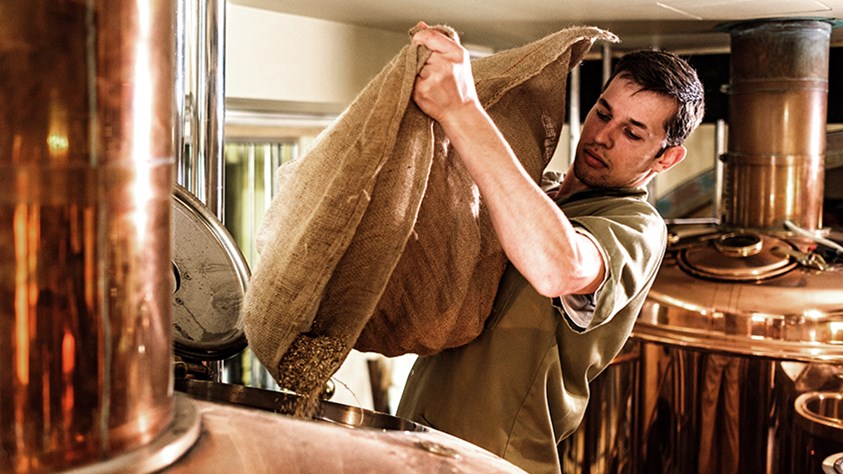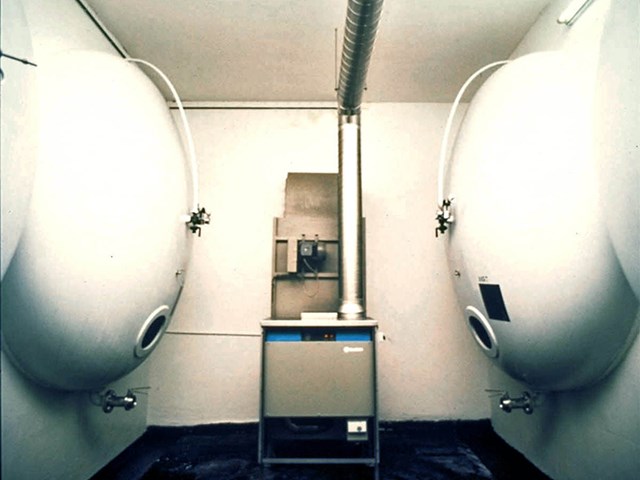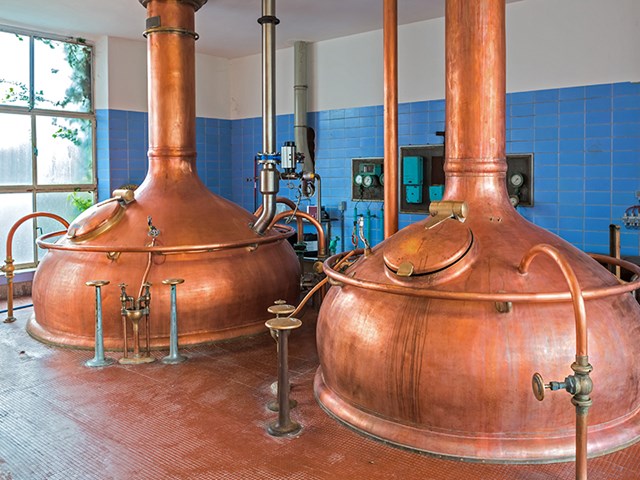W Leuven w kilka zbiorników magazynowych wystaje przez ścianę w korytarzu i ochładzane są do + 2 ° C a za pomocą powietrza o temperaturze -2 ° C, które krąży w budynku. W chłodzonym budynku, przy temperaturze powierzchni wynoszącej + 2 ° C powietrze może zawierać tylko 4g wilgoci / kg powietrza, ale w lecie, ze względu na wyższą temperaturę, powietrze zewnętrze może zawierać więcej niż 15g wilgoci / kg powietrza. Niestety instalacja klimatyzacyjna nie jest w stanie usunąć wystarczającej wilgoci i nie można uniknąć kondensacji.
Kondensacja i wysoka wilgotność są idealnymi warunkami dla rozwoju pleśni i bakterii, więc w Leuven wszystkie korytarze były myte gorącą wodą i detergentami raz lub dwa razy w tygodniu, aby temu zapobiec. Rozwiązanie to powodowało narastanie problemu, poprzez dodstarczanie większej ilość wody do usunięcia.
Tradycyjnym sposobem radzenia sobie z kondensacją było powietrze wentylacyjne odprowadzające odparowaną wilgoć. Jednakże, o ile wprowadzane powietrze nie ma wilgoci, a punkt rosy jest znacznie poniżej temperatury zbiorników (sporadycznie pojawia się w zimie), jest to podejście całkowicie niewłaściwe.
Firma Munters zainstalowała dwa osuszacze o wydajności 1200 m3 / godz., A czas suszenia zmniejszył się do 1 dnia po myciu, przy czym w korytarz utrzymywana jest 40% wilgotność względna (RH) w zakresie 5-10 ° C, co skutkuje całkowitym zapobieganiem kondensacji.
Stella Artois zdecydowała się na zainstalowanie kolejnych dwóch systemów Munters, z których każde dostarcza 15000 m3 / godzinę, utrzymując stałą wilgotność względną 40% w temperaturze 10 ° C, aby przyspieszyć suszenie po myciu. Efektywne suszenie korytarzy i niski poziom wilgotności praktycznie eliminują ryzyko wzrostu mikrobiologicznego i obniża koszty utrzymania.
Ponieważ poziom wilgotności powoduje wysychanie stojącej wody w ciągu jednego dnia, wymagania obsługowe zostały znacznie zmniejszone w stosunku do poprzednich. Renowacja nie jest już częstą koniecznością,ponieważ niższy poziom wilgotności w korytarzach powoduje mniej migracji wilgoci i infiltracji, zmniejsza się zamarzanie parowników i potrzeba mniej energii na odszranianie.
A cleaner environment
At the brewery in Leuven, several storage vessels protrude through the wall into a corridor and are cooled to +2 °C by air which is chilled to -2 °C and circulated through the storage buildings. In the cooled building, with surface temperatures at +2 °C the air can contain only 4g moisture/kg air, but in summertime, due to its higher temperature ambient air can hold more than 15g moisture/kg of air. Unless the air conditioning plant is capable of removing sufficient moisture, condensation cannot be avoided.
When ambient air is allowed to infiltrate into the buildings, condensation problems occur on the vessels, pipework and the cold wall surfaces in the corridors. This is unavoidable as the buildings are not hermetically sealed, also door openings for operators and maintenance personnel add to the water vapor introduced by infiltration that will cause condensation.
Condensation and high humidity are ideal conditions for mold and bacterial growth, and at Leuven all corridors were washed with hot water and detergents once or twice a week to prevent this. These cleaning regimes exaggerate the problem by increasing the amount of water needing to be removed.
Regular decoration to the structure was required due to the deterioration experienced as a result of continual high humidity and condensation.
The traditional means of dealing with condensation involved ventilation air to carry away the evaporated moisture. However, unless the air being introduced has a moisture content, with a dew point well below the temperature of the storage vessels (occasionally occurring during winter) this is a totally unpredictable approach.
The right dehumidification
Munters installed two 1,200 m3/hr dehumidifiers with the drying time reduced to 1 day after washdown, and the corridor maintained at 40% relative humidity (RH) between 5-10°C, the result being the total prevention of condensation.
Stella Artois decided to install a further two Munters systems each handling 15,000 m3/hr maintain a constant 40% RH at 10 °C to speed up drying after washdown. The efficient drying of the corridors and low humidity level, now virtually eliminates the risk of microbiological growth and maintenance costs have been reduced.
Reduced health risks
The ability to provide adequate and efficient drying to the corridors and maintain a low humidity level, now virtually eliminates the risk of microbiological growth and maintence costs have been reduced.
As the humidity level is now controlled to eliminate condensation and dries standing water in one day, the previous maintenance requirements have been dramatically reduced. Redecoration is no longer a frequent necessity.
The refrigeration plant for controlling temperature in the vessel building operates at much more efficient levels now. As the lower moisture level in the corridors produces less moisture migration and infiltration, frosting on the evaporators has been reduced and less defrost energy is needed to remove it.



